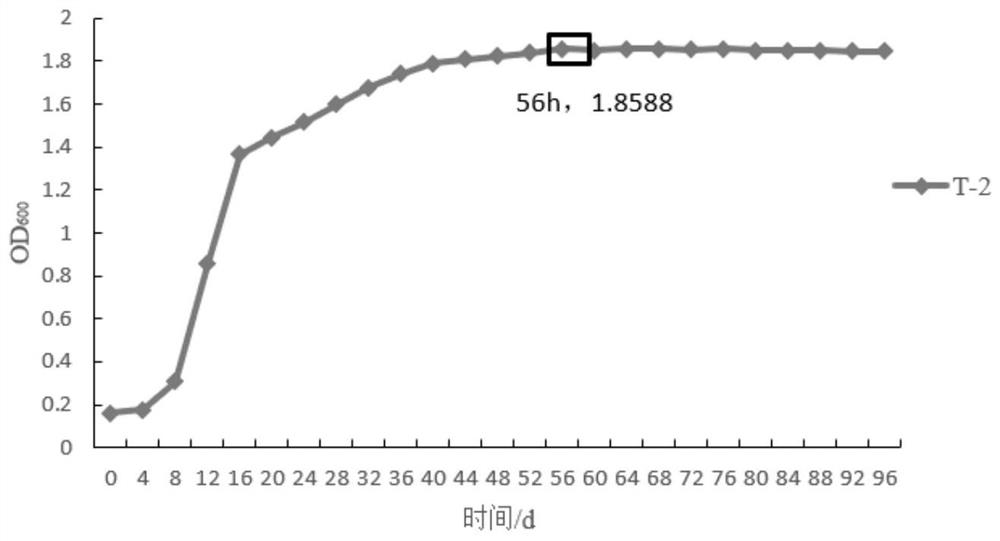A kind of Maggi mech's yeast and its application
A technology of Mechi yeast and Maggi, applied in the field of microorganisms, can solve the problems of stable control effect without chemical fungicides, shallow depth, and not as easy to use as chemical reagents.
- Summary
- Abstract
- Description
- Claims
- Application Information
AI Technical Summary
Problems solved by technology
Method used
Image
Examples
Embodiment 1
[0045] Isolation and strain identification of Metschnikowia sp. T-2 of the present invention
[0046] 1. Sample collection
[0047] Fresh blueberries were purchased from Tianjin Hongqi Farmer's Fruit Wholesale Market.
[0048] 2. Isolation and screening of strains and antagonistic screening
[0049] Isolate strains from fresh blueberries, use conventional gradient dilution coating to separate, use YPD agar (containing ampicillin 25mg / L) medium to culture at 28°C, 180rpm, pick colonies with large differences in colony morphology and pure culture , purified and preserved on YPD agar medium (containing ampicillin 25mg / L), and carried out preliminary screening and multiple re-screening of antagonistic bacteria with blueberry postharvest Botrytis cinerea and Alternaria as target pathogens, and finally obtained a strain The yeast-like strain with strong antibacterial activity was named T-2.
[0050] 3. Identification of strains
[0051] Morphology and partial conserved sequences...
Embodiment 2
[0054] The low temperature tolerance test of Metschnikowia sp. T-2 of the present invention.
[0055] At present, the suitable growth temperature range of yeast (Metschnikowia sp.) reported in the literature is generally 20-30°C, and it cannot grow under the condition above 40°C. For example, the authorized patent "A Maggi Meki Yeast and Its Application" CN105349442B, the authorized patent "A Maggi Meki Yeast and Its Application for Inhibiting Fungi" CN 103642705, and the authorized patent "A Strain of Hansen Debariae hansenii strains and their application in "CN 104988082B" all the Debariae hansenii strains grow weakly at an ambient temperature of 4°C. However, Metschnikowia sp. T-2 described in this application grows well at 4°C, as shown in Figure 3(a), indicating that it is extremely resistant to low temperature and has extremely high low temperature tolerance .
[0056] The specific test method is as follows:
[0057] An equal amount of Metschnikowia sp. T-2 strain (1×...
Embodiment 3
[0059] Because blueberries belong to small berry fruits, and this type of fruit also includes grapes, strawberries, cherries, cherry tomatoes, etc., it has been proved by literature ([1] Li Ning. Detection of postharvest rot-causing bacteria in grapes and fungal elicitor-induced resistance [D]. Yang Ling, Northwest Agriculture and Forestry University 2005. [2] Reglinski T. Inhibition of Botrytis cinerea growth and suppression of botrytis bunch rot in grapes using chitosan [J]. Plant Pathology, 2010,59(5):882–890 .[3] Du Xiaoqin, He Jingliu, Qin Wen, et al. Research progress on the inhibitory effects of postharvest pathogenic bacteria and plant essential oils on sweet cherry fruits [J]. Food Industry Science and Technology, 2015(21): 368-371.[4] Alique R, Zamorano J P, Martínez M A, et al. Effect of hea and cold treatments on respiratory metabolism and shelf-life o sweet cherry, type picota cv “Ambrunés” [J]. Postharvest Biology and Technology, 2005, 35(2): 153-165.[5]Williamso...
PUM
 Login to View More
Login to View More Abstract
Description
Claims
Application Information
 Login to View More
Login to View More - R&D
- Intellectual Property
- Life Sciences
- Materials
- Tech Scout
- Unparalleled Data Quality
- Higher Quality Content
- 60% Fewer Hallucinations
Browse by: Latest US Patents, China's latest patents, Technical Efficacy Thesaurus, Application Domain, Technology Topic, Popular Technical Reports.
© 2025 PatSnap. All rights reserved.Legal|Privacy policy|Modern Slavery Act Transparency Statement|Sitemap|About US| Contact US: help@patsnap.com



